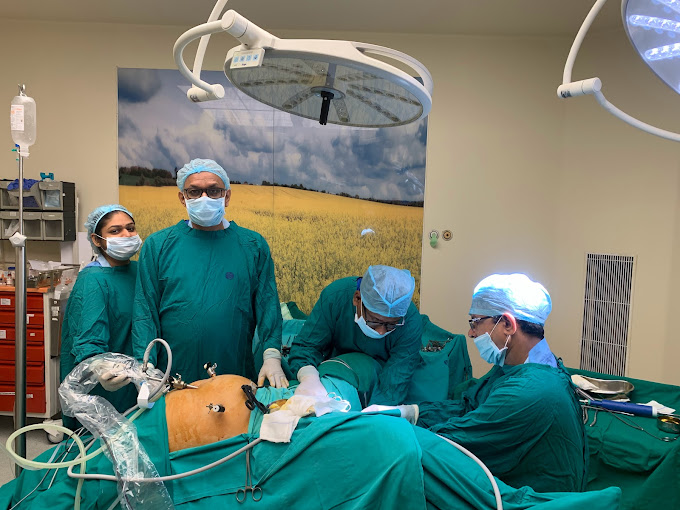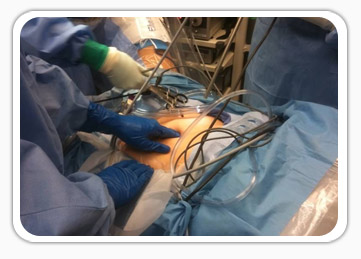Services We offer
- Caesarean Section
- Laparoscopic Surgery
- Laparoscopic Surgery in Infertility
- Hysteroscopic Surgery
- Infertility
- Laparoscopic Creation of Neovagina
- High Risk Pregnancy
- Laparoscopic Tubal Recanalization
- Hysterectomy
- Myomectomy
- Endometriosis
- Diagnostic Laparoscopy
- Urogynaecology
- Vaginal Surgery
- Caesarean Delivery
- Tubal Block Surgery
- Bad Obstetric History(BOH)
- Normal Delivery

Laparoscopic Surgery in Infertility
Laparoscopy is the examination and inspection of the interior of body organs or cavities using a device called an endoscope. Our unit performs all fertility promoting endoscopic procedures. Endoscopy involves laparoscopy as well as hysteroscopy.
Laparoscopy involves visualization of pelvic structures (uterus, tubes & ovaries) with the help of a special optical device called as laparoscope. Operative intervention can be done simultaneously, which helps in restoring the pelvic anatomy & improving your chance of conception.
Hysteroscopy is a surgical procedure that enables us to diagnose and operate on pathologies inside the cavity of the uterus. This consists of the introduction of an instrument with fibre optics called hysteroscope, through the cervical canal, which enables us to visualize the cavity of the uterus. We can diagnose and treat any existent uterine pathologies simultaneously.

We have state of the art, fully equipped dedicated theatres where these endoscopic procedures are performed usually as day care procedures and the patient does not need to be admitted overnight.
LAPAROSCOPY:
Laparoscopy is an operative procedure done under general anaesthesia that allows intra abdominal surgery to be performed with the help of a special optical device called laparoscope. This is inserted through a tiny incision made in the abdominal wall near the navel for viewing the abdominal cavity. By introducing special instruments though additional incisions or cut over abdomen it is possible to perform minimally invasive surgical procedures without the need of creating a large opening in the abdominal wall.
WHY DOES ONE REQUIRE LAPAROSCOPY?
Laparoscopy is an important diagnostic tool in the evaluation of an infertile patient. An inspection through the laparoscope gives us a general impression of the state of the pelvis and enables us to find the cause of infertility. Also, the tubal patency can be checked by injecting a blue dye into the uterus, through a thin tube inserted through the cervix (mouth of the uterus), and seeing it spill out though the tubes. In addition the laparoscope can also be used to safely carry out operative procedures, which enhance fertility.

Moreover, if you want a risk-free gynecologist laparoscopic surgery, Dr. Sankar DasMahapatra is here to help you.
COMMONLY DONE PROCEDURES BY LAPAROSCOPY
• Assessment of tubal patency by chromopertubation
• Adhesiolysis to clear tubes, ovaries and uterus and restore normal anatomy of pelvis
• Laparoscopic Ovarian drilling in PCOS
• Cyst removal from ovaries
• Laparoscopic Endometriotic cyst drainage and fulgurating all endometriotic deposits in the cyst
• Clearance of endometriosis including fulguration of all possible deposits in pelvis
• Obtaining biopsies to confirm diagnosis if in doubt from ovaries, tube or deposits in the pelvis
• Opening of the distal end of tubes
• Removal of ectopic pregnancy
• Removal of fibroids protruding on the surface of the uterus
• Clipping or removal of tubes before IVF in case of gross hydrosalpinx
• Controlling hysteroscopic septum resection or hysteroscopic adhesiolysis by direct visualization by laparoscope simultaneously, to prevent injury to uterus or any other surrounding structures
• Confirming successful cornual cauterization to achieve tubal patency by seeing spillage of dye from the outer end of the tube.
ADVANTAGES OF LAPAROSCOPY OVER OPEN SURGERY
• Smaller and cosmetically better scars
• Reduced pain after surgery
• Shorter stay in the hospital
• Less chances of wound infection
• Faster recovery and resumption of normal activity
COMPLICATIONS OF LAPAROSCOPY
• Inability to perform the procedure due to technical problems or extreme obesity
• Intended laparotomy (open surgery) in the best interest of the patient whenever required
• Injury to internal organs and blood vessels
HYSTEROSCOPY
Hysteroscopy is an operative procedure performed under general anaesthesia where a telescope is introduced into the uterus through the vagina to visualize the inside of the uterus.
WHY DOES ONE REQUIRE HYSTEROSCOPY?
Hysteroscopy is done to visualize the inside of the uterus to make sure that there are no pathologies, which could cause infertility and which if present, can be corrected simultaneously by operative hysteroscope to improve fertility.

HYSTEROSCOPY CAN TREAT FOLLOWING CONDITIONS:
• Visualization of cavity of uterus and site specific targetted biopsies whenever necessary
• Removal of endometrial polyps
• Removal of sub- mucous fibroids
• Clearance of adhesions in the cavity of the uterus
• Excision of uterine septum
• Removal of foreign bodies or old products of conception or embedded intra uterine contraceptive devices
• Cornual catherizationto open up the tubes
• Insertion of ESSURE for proximal tubal occlusion
COMPLICATIONS OF HYSTEROSCOPY
• Inability to perform the procedure due to technical problems
• Poor visualization due to thickened endometrium/ poor distension
• Difficult cervical dilation due to fibrosis/ cervical ridge
• Uterine perforation